If, like me, you’re an absolute sucker for any plant with a bluish or purplish tint – you’re going to love this one.
Let me introduce you to the highly desired Cebu Blue Pothos, an Epipremnum pinnatum variety with stunning silvery blue leaves that will absolutely steal your heart.
Hailing from Cebu Island in the Philippines, this vibrant vine can be found climbing up the native trees. And now, it’s rapidly spreading itself across the world (like the invasive species it is) and is promptly earning itself hot houseplant trend status!
I can see why; it’s an absolute feast for the eyes.
Also known as the Dragon-Tail Plant, Tibitib, and Centipede Tongavine; the Cebu Blue will certainly delight you, excite you, and (as I’m about to explain why) probably surprise you.
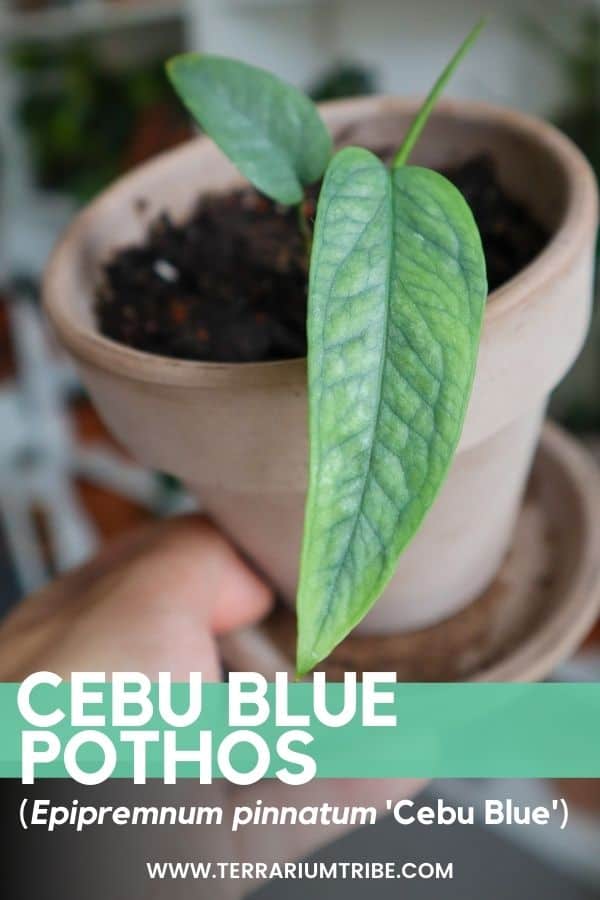
What is the Cebu Blue Pothos? (Really)
A quick trip down Google Lane will show you that the Cebu Blue frequently gets mistaken for a Philodendron and Monstera all of the time.
Honesty, I have no idea why it’s confused with Philodendron, but I’m guessing that the Monstera confusion has something to do with its two distinct phases.
The Cebu Blue looks extremely different in maturity compared to infancy (making it similar to many Monstera varieties in that respect).
In the wild, it starts life with its dainty little lance-shaped leaves and then develops deep fenestrations (holes in leaves) later in life that look utterly marvelous.
It’s truly one of the most dazzling tropical plants you’ll lay your eyes on.
It can develop fenestrations when it’s kept as an indoor plant, too. It’s unclear how common it is and how long it takes – but it’s definitely possible.
My understanding is that you just need to have patience, match its natural habitat, and make it really, really happy.
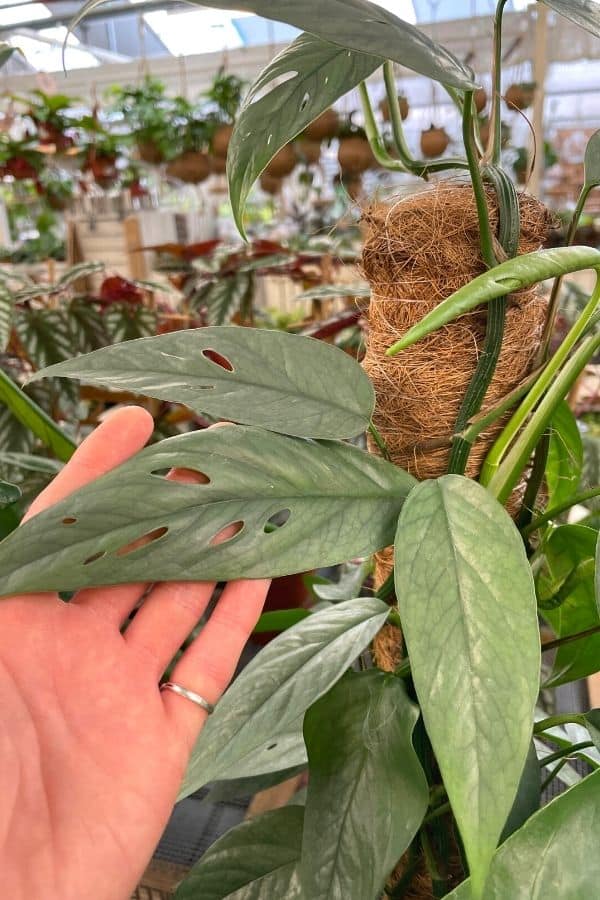
And that, ladies and gentlemen, I’m here to help with.
Luckily for us, Cebu Blue care is a lot more straightforward than some of its aroid pals. Let’s get into it!
Where to Find Cebu Blue Pothos for Sale
See the links below to purchase from reputable terrarium plant shops and marketplaces (may include affiliate links).
Cebu Blue Pothos Care & Growth
At a Glance
| Plant Type | Vine |
| Lighting | Medium – high indirect light |
| Temperature | 50-97°F (10-35°C) |
| Watering | Regular, even moisture |
| Humidity | Medium-high humidity (60-90%) |
| Growth | 5ft+ trailing vine (10ft+ climbing) |
Light
A tropical vine, you say? Well, it should come as no surprise that it, in fact, likes bright indirect light.
Aim to place it a few feet away from a window, where it gets lots of bright light but no direct beams.
I wouldn’t worry if it gets a little direct light. An hour or so here or there should be fine, especially in the colder months. After all, I’m sure in its natural environment, it would sneak a few rays from beneath the rainforest canopy.
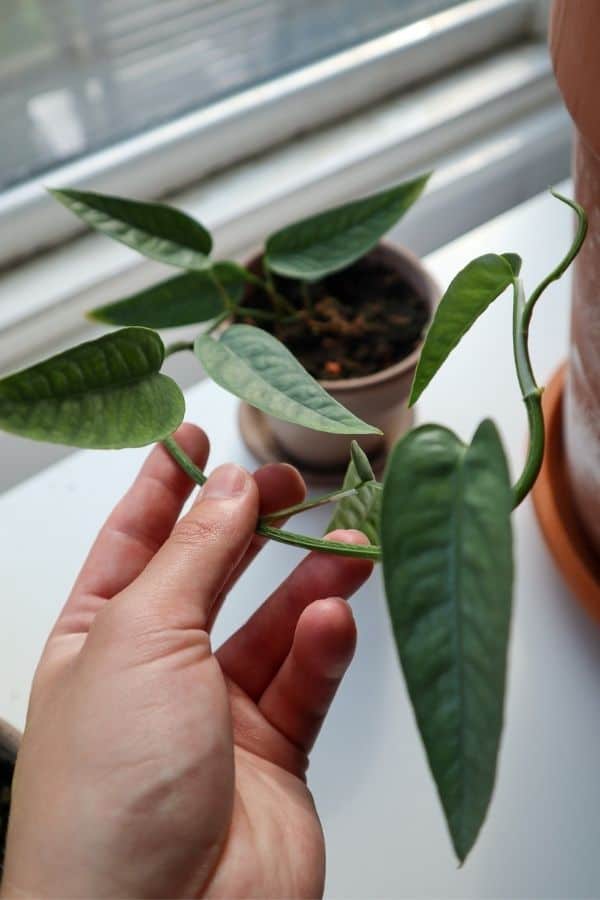
But, I’d be very wary of it being regularly sat in direct sunlight for anything more than a little morning sun.
The Cebu Blue Pothos is known to be a little less robust than its aureum cousins (Golden Pothos, etc.) when it comes to light requirements, so avoid putting it in a low-light spot if possible.
If, like me, you’re sharply running out of bright indirect spots (known as houseplant prime real estate in our household), you can always whack it under a grow light – problem solved.
Watering
Luckily for us, Pothos are pretty low-maintenance when it comes to watering requirements.
As a vining plant, the Cebu Blue naturally grows up the trees where it would cyclicly be soaked and left to dry out, and I’d definitely try to mimic that process in your watering schedule.
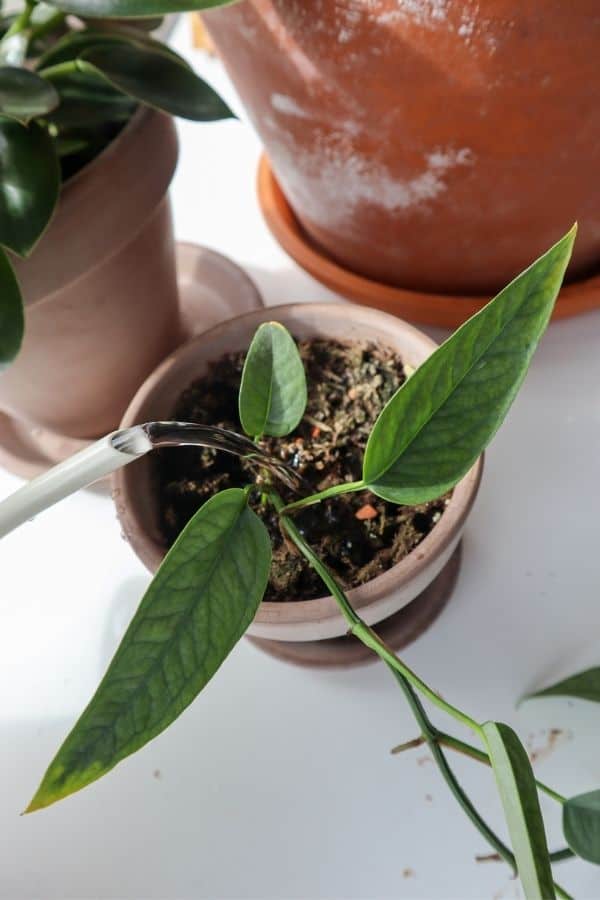
The main thing you’ll need to keep an eye on with this plant is that it’s not sat in soggy soil – it’s the fastest way to ruin a healthy plant. The Cebu Blue is an epiphytic vine, not a swamp monster. It won’t love you if you subject it to such mushy conditions.
In the rainforest, this plant would have mother nature’s finest draining system, so in the home, your plant will need a pot with a drainage hole or a terrarium with a drainage layer to prevent root rot.
I evenly water my Cebu Blue until I see water come into the drainage tray, tip the water away (usually into one of my water-hungry Alocasias), and then leave my plant alone until the soil feels fairly dry to the touch. Then rinse and repeat forever.
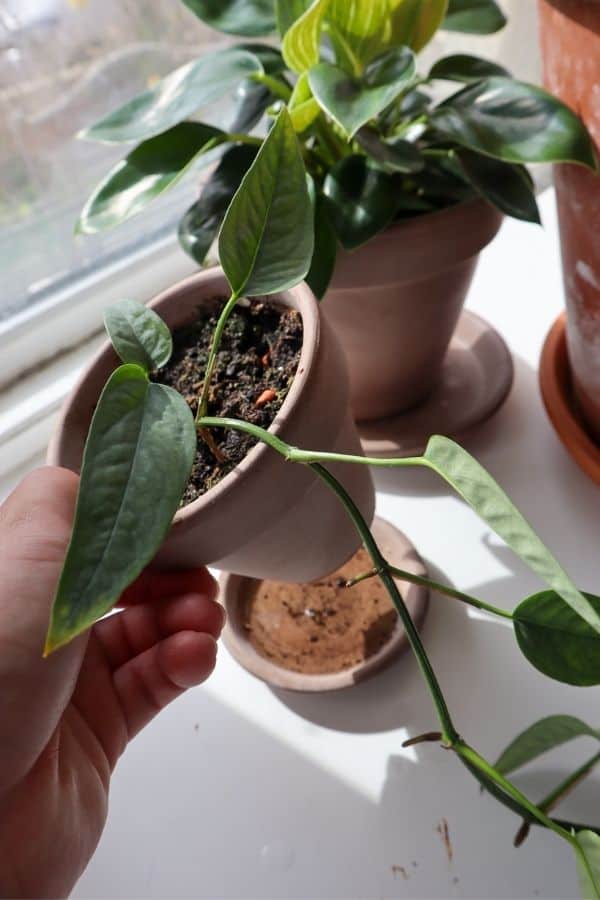
In a terrarium, you’ll need to carefully balance the amount of water in the system by adding a little at a time until the substrate is evenly moist but not wet.
Substrate
Epipremnum aren’t overly picky plants, so I wouldn’t stress about soil too much. It would likely do fine with good-quality potting soil.
If you’re putting this plant in a terrarium, however, getting your substrate mix spot on is much more critical.
Your Cebu Blue Pothos will really appreciate a chunky mix with plenty of root aeration and good drainage.
My terrarium substrate mix is similar to a typical aroid mix, using a coco coir base with plenty of orchid bark, sphagnum moss (and occasionally some extra perlite or vermiculite).
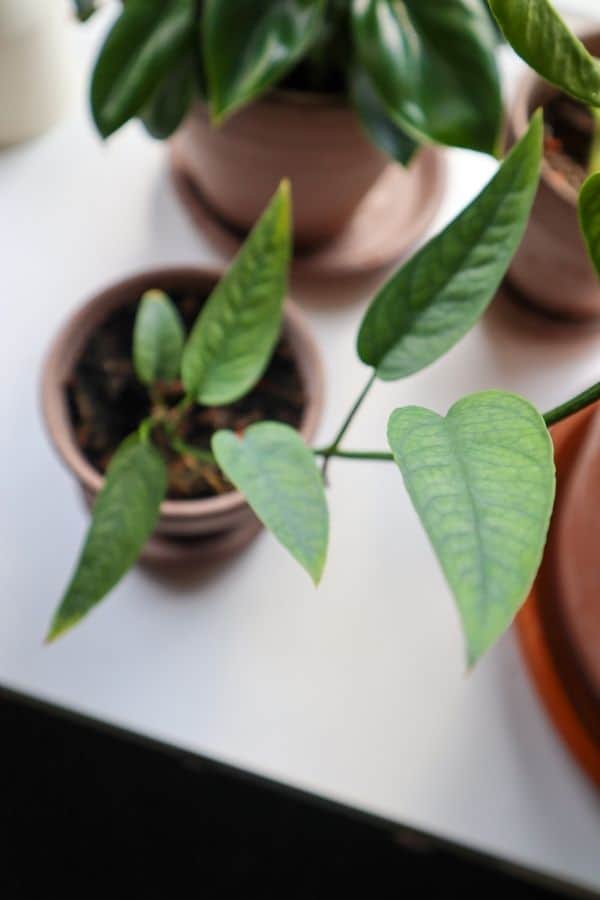
Temperature & Humidity
As an invasive vining species, it’s fair to say that this plant comfortably grows outside in tropical and subtropical areas and is able to withstand the seasons and a wide range of temperatures.
The lower limit for this plant being 50°F (10°C), and the upper limit 97°F (35°C), so you’re unlikely to have any issues with our cushy 21st-century indoor temperatures.
Again, the Cebu Blue isn’t picky, but it has a preference for an environment with a higher humidity level. Anything in the 60-90% range should be well received.
I always like to look at where the plant comes from, and Cebu Island (where it literally evolved from) stays in the range the 70-85% all year round – so if you aim for that, then you’ll have one happy Epipremnum.
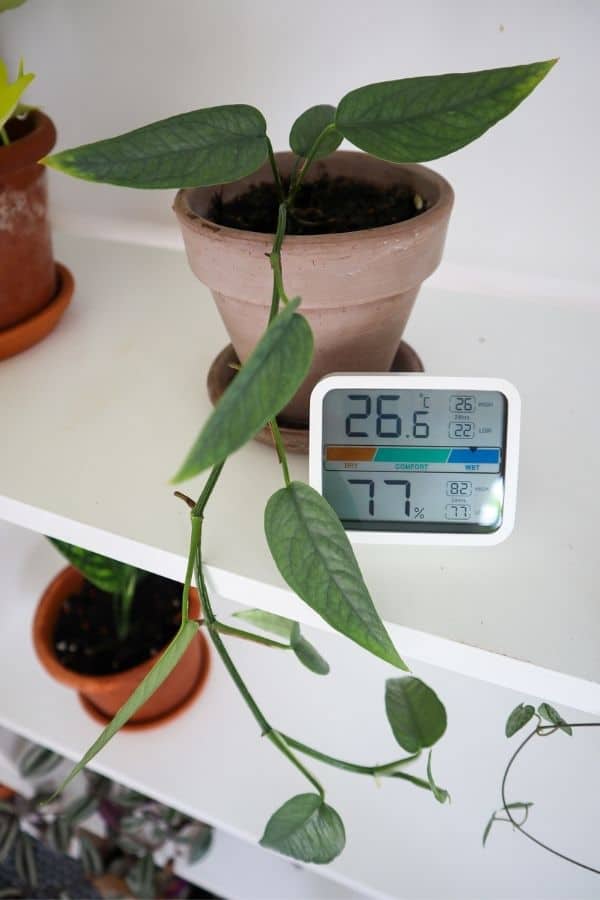
Growth
Like many tropical vines, this lovely plant needs something to climb up.
A vine wanna do what a vine wanna do.
Letting it climb something like a moss pole will mirror its natural environment and allow the plant to mature out of its juvenile phase, encouraging it to develop those much-desired fenestrations and mature leaves.
In fact, a moss pole would be best as the aerial roots can directly attach to it, as they would a tree epiphytically. They can even reach 30ft up the trees in the wild!
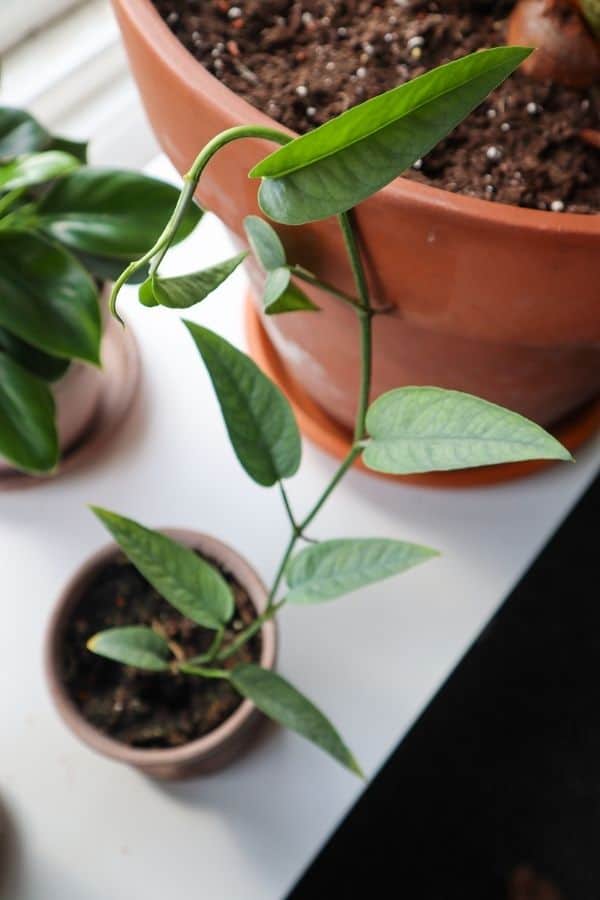
Alternatively, if you’re not too fussed about achieving split leaves – this plant looks fabulous trailing from a shelf or hanging basket or spilling across a terrarium floor.
You can expect lots of fast, healthy growth from this plant, so it’s likely you’ll need to trim it regularly unless you have a really large terrarium container. Though that just means more cuttings to propagate, right?
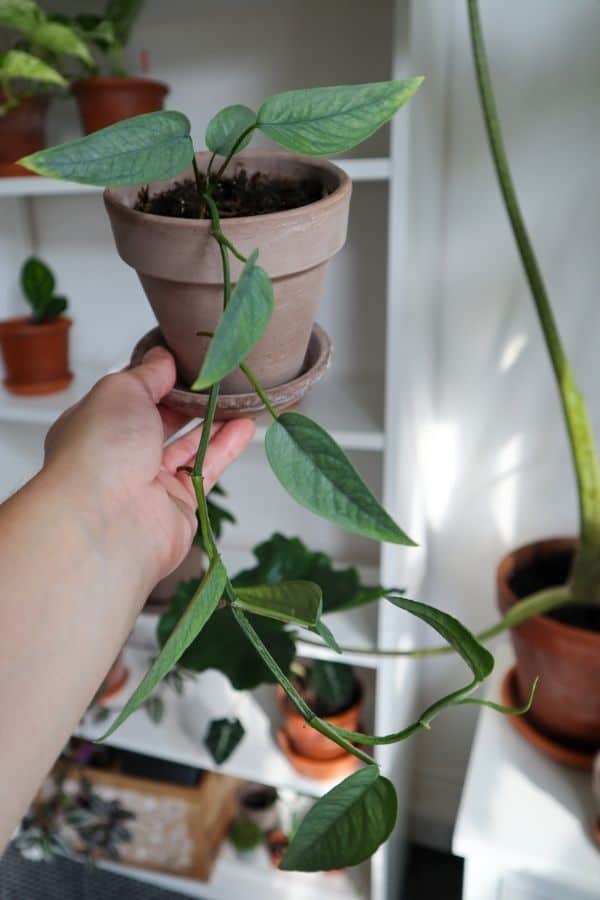
Propagation
You can propagate this plant in water super easily.
Grab your mother plant and give her a haircut. Snip beneath the root node (ensuring you have at least one leaf attached) and put your cuttings in water. There you have it.
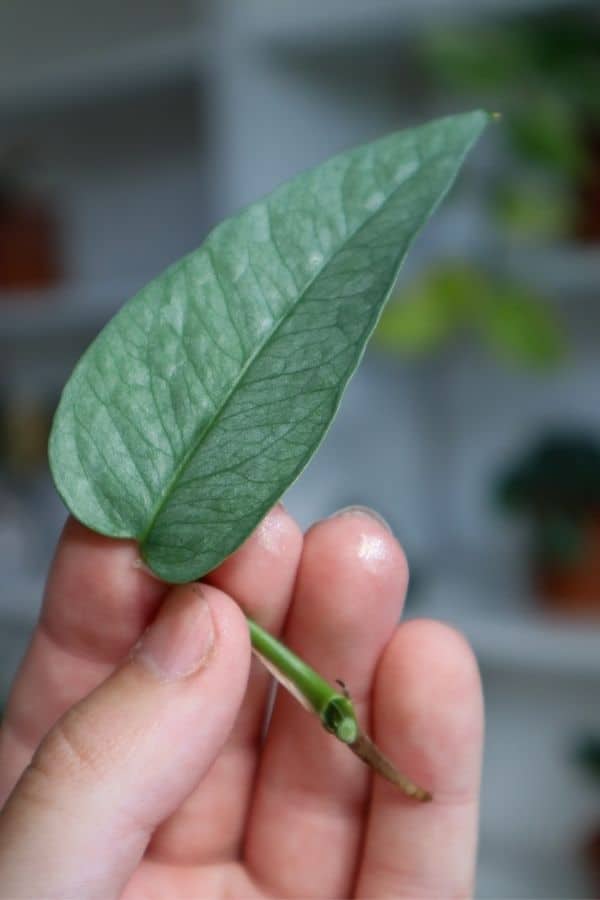
I like to dip my cutting in rooting hormone, too, but it’s not necessary; you should get plenty of root growth without any assistance.
As soon as you see baby roots coming of your big root, pot that pretty little thing up in some nice well-draining soil, and you have not one, but two Cebu Blue Pothos!
You get a plant, you get a plant, and YOU get a plant!!
You can also propagate cuttings in soil if that’s how you roll; they should readily root up in a hot and humid terrarium environment.
Varieties & Similar Plants
Buckle up, kids; this is going to be a chunky section. There are so many types of Pothos to sink your teeth into (metaphorically – they’re all super poisonous).
There’s the standard Epipremnum pinnatum, exactly like the Cebu Blue, from what I can tell, just with delicious deep green leaves. You can also get white and yellow variegated forms that look marvelous (and sell for around a third of the eye-watering price a variegated Monstera deliciosa typically sells for…).
But the stand-out variety has to be the Skeleton Key Pothos.
Its leaves are absolutely WILD – I’ve genuinely not seen something so unique, and I really want one.
There are so many Pothos plants up for grabs if you’re willing to jump over to the Epipremnum aureum genus. From the vibrant Neon Pothos and the deep green Jade Pothos, to the variegated varieties like the Pearls and Jade, Marble Queen, Manjula, and Njoy Pothos, there’s something for every plant-obsessed collector!
And now, going even further afield, there’s also the Scindapsus pictus, commonly known as the Satin or Silver Pothos.
Frequently Asked Questions
Well, the Cebu Blue Pothos is an aggressive grower, so it’s certainly not rare in the grand scheme of things, but in terms of how easy it is to source as an indoor plant, it can be. I definitely found it tricky to get my hands on one and ended up spending more than I would have liked on a single-leaf cutting.
There’s potentially another Epipremnum pinnatum variety called “blue form,” but the jury is still out on whether that actually exists or is just the Cebu Blue. From my research, I’m voting for “doesn’t exist,” as there’s zero documentation I could find on it.
Yes, unfortunately, each and every member of the aroid family – despite being the most gorgeous family of plants – is toxic to both people and pets. So if you have little mouths around the house, either keep it out of reach (terrariums are great for this) or give it a miss.
The Cebu Blue Pothos is… a Pothos! It’s a member of the Epipremnum pinnatum genus, and despite the many similarities they share being tropical plants, it’s definitely not a Philodendron.
It’s probably a sign of over or under-watering. Make sure your pot has drainage and your soil mix drains well; only water when it’s a little dry to the touch. On the opposite end of the scale check, you’re not leaving it to go bone dry between waterings.
